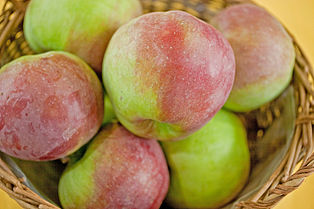Bismarck apple
| Bismarck apple | |
|---|---|

|
|
| Art | Cultivated apple ( Malus domestica ) |
| origin | Tasmania |
| known since | 1870 |
| ancestry | |
| List of apple varieties | |
The Bismarck apple , also called Bismarck , Prince Bismarck , is a cultivar of the cultivated apple . It is a robust, storable, large cooking apple for low stems and higher altitudes.
The Bismarck apple came to Europe in 1870 from the city of Bismarck in Tasmania via New Zealand and England around 1888. Another apple variety exists under the name Fürst Bismarck , although it is not identical to the variety described here.
The variety is very well suited for growing in bush form and is therefore still fairly well represented in garden fruit growing despite its other properties. In good soils, it can be grown at medium altitudes. The strong growth in the first few years is reduced, but later occasional, stronger prunings remain necessary. The yield starts medium early and is rather regular.
Flowering begins mid-early, but is not sensitive. The Bismarck apple is large-fruited, flat-round and slightly ribbed. Its skin is yellow to white-greenish, the surface color light to brown-red. The pulp is white. The apple has a sour taste, has a weak spicy taste and, as a winter apple, is ripe for consumption from November and ideally can be stored until March. The fruits are also suitable as table apples, as well as very good for cooking, roasting and baking.
The tree, which is somewhat susceptible to diseases such as scab , fruit tree canker and powdery mildew, is frost-resistant in the wood . The variety is a commercial apple, which is suitable for orchards .
literature
- B. Bartha-Pichler: Rose Apple and Goldparmäne . ISBN 3-03800-209-7 , 2nd edition 2006


